Technology and project updates from U-M Library Information Technology.
Library Tech Talk
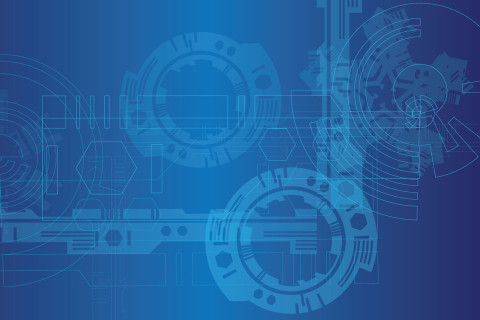
Posts in Library Tech Talk
Showing 1 - 10 of 137 items
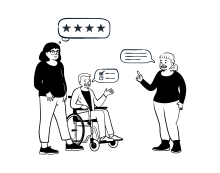
- Ben Howell
The second Library Search Benchmark Survey launched earlier this year and we gathered feedback from students, faculty, staff and library employees about finding and accessing materials through Library Search. We also measured changes in user satisfaction, ease of use, user challenges and wins from our first survey in 2022. Participation from users outside the library grew significantly and responses helped us identify clear and actionable insights we’re excited to share and act on in the coming year.
•
- Jeremy Evans
- Larry Wentzel
Collaborating on a Digital Music Archive: U-M's contributions to the Sounding Spirit Digital Library
In 2020, the Emory Center for Digital Scholarship in Atlanta, Georgia reached out to the University of Michigan to contribute to the Sounding Spirit Digital Library (SSDL). They asked the Bentley Historical Library, the U-M Library, and the William L. Clements Library to contribute titles in our collections that would expand their digital collection. This post looks at the range of titles contributed, discusses the equipment used to digitize the titles, and analyses the ways that SSDL and U-M Library align and vary in their digitization efforts.

- Eliot Scott
Finding legitimate use cases for Artificial Intelligence on the Library Blogs site proved to be difficult after four experiments. Tests include running Hugging Face, Ollama with two different LLMs, U-M Maizey and Google NotebookLM. Costs of AI in maintenance, storage and processing, as well as environmental concerns were deemed too high and outweigh the benefits and value added to the site.
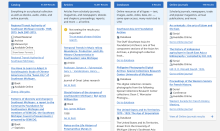
- Ken Varnum
LIT’s Design and Discovery department received generous support from an anonymous donor to fund a Library User Experience Research Fellow position. Our first fellow was Suzan Karabakal, a master’s student at the U-M School of Information. She investigated and recommended changes to the way Library Search presents results. Suzan conducted user research to identify specific changes we could make to improve our “Everything” results screen and search results for Catalog and Articles.
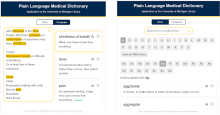
- Josh Salazar
In 2024, updates to the Plain Language Medical Dictionary (PLMD) included big improvements for accessibility and user experience, plus adding support for images. We fixed contrast issues, unclear icons, and missing labels to meet WCAG 2.1. Search also got smoother, and instructions are now clearer. In addition, we added image support with JSON updates for URLs and alt text. With our legacy hosting environment shutting down, we moved the PLMD moved to GitHub Pages as part of the project. This provides better stability and automatic updates via GitHub Actions.

- Heidi Burkhardt
As part of a broader product accessibility initiative in Library Information Technology, the team behind the library’s website undertook a number of remediation efforts based on the findings of the site’s baseline accessibility evaluation. The work demonstrates how accessibility remediation can also be an opportunity for code clean-up, usability improvements, and refreshing design elements.
- Ken Varnum
When we moved our library catalog from Aleph to Alma in 2020, we left behind the Aleph OPAC (also known as Mirlyn Classic), which we had used as our “legacy” catalog for years even after moving first to a VuFind-based discovery layer (known as VuFind Mirlyn), and then to our current, homegrown, Library Search application. This describes how we built our authority browse features.

- Ken Varnum
- Ben Howell
- Emma Brown
How we designed and built our “nearby on shelf” feature for Library Catalog records.
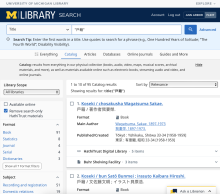
- Ken Varnum
The U-M Library recently added the capability to search across Chinese-language materials in our catalog, regardless of which Chinese character set was used in the query or the record. This improvement expands to our large collection of materials and improves the user experience.

- Nabeela Jaffer
Academic library service portfolios are mostly a mix of big to small strategic initiatives and tactical projects. Systems developed in the past can become a durable bedrock of workflows and services around the library, remaining relevant and needed for five, ten, and sometimes as long as twenty years. There is, of course, never enough time and resources to do everything. The challenge faced by Library IT divisions is to balance the tension of sustaining these legacy systems while continuing to innovate and develop new services. The University of Michigan’s Library IT portfolio has legacy systems in need of ongoing maintenance and support, in addition to new projects and services that add to and expand the portfolio. We, at Michigan, worked on a process to balance the portfolio of services and projects for our Library IT division. We started working on the idea of developing a custom tool for our needs since all the other available tools are oriented towards corporate organizations and we needed a light-weight tool to support our process. We went through a complete planning process first on whiteboards and paper, then developed an open source tool called TRACC for helping us with portfolio management.